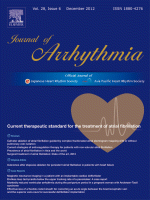Current issue
Special Issue: Current therapeutic standard for the treatment of atrial fibrillation
Displaying 1-9 of 9 articles from this issue
- |<
- <
- 1
- >
- >|
Reviews
-
2012 Volume 28 Issue 6 Pages 311-323
Published: 2012
Released on J-STAGE: November 16, 2012
Download PDF (2677K) -
2012 Volume 28 Issue 6 Pages 324-329
Published: 2012
Released on J-STAGE: November 16, 2012
Download PDF (491K) -
2012 Volume 28 Issue 6 Pages 330-337
Published: 2012
Released on J-STAGE: November 16, 2012
Download PDF (469K) -
2012 Volume 28 Issue 6 Pages 338-346
Published: 2012
Released on J-STAGE: November 16, 2012
Download PDF (806K)
Original Article
-
2012 Volume 28 Issue 6 Pages 347-352
Published: 2012
Released on J-STAGE: November 16, 2012
Download PDF (440K)
Case Reports
-
2012 Volume 28 Issue 6 Pages 353-355
Published: 2012
Released on J-STAGE: November 16, 2012
Download PDF (464K) -
2012 Volume 28 Issue 6 Pages 356-359
Published: 2012
Released on J-STAGE: November 16, 2012
Download PDF (623K) -
2012 Volume 28 Issue 6 Pages 360-363
Published: 2012
Released on J-STAGE: November 16, 2012
Download PDF (714K) -
2012 Volume 28 Issue 6 Pages 364-366
Published: 2012
Released on J-STAGE: November 16, 2012
Download PDF (325K)
- |<
- <
- 1
- >
- >|
